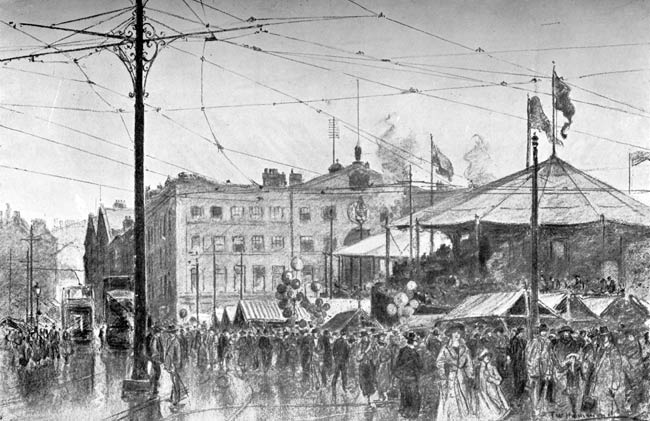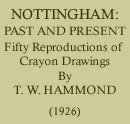< Previous | Contents | Next >
NOTTINGHAM PAST & PRESENT: STREETS AND YARDS
THE MARKET PLACE, showing Goose Fair, 1913

The annual pandemonium of Goose Fair, held during the first week in October is the event from which all Nottingham activities date themselves. For three days the town is given up to noise and merry-making and in spite of numerous attempts to suppress it or to move it to a more convenient centre than the Market Place, Goose Fair shows signs of remaining where it is for many years to come. It was originated as far back as 1541 as a business fair, but its utility has long since disappeared and it is now merely a pleasure fair.
Nottingham Market Place is the pride of the city; it is more than five acres in extent and is the largest open market in England, and with the pleasing bustle on market days when the country folk bring in their many-hued products it presents a scene of beauty and gaiety which is far removed from the sombre colours usually associated with English commerce.
Mr. Hammond's picture shows us, in the distance, the Exchange, which has had a varied but rather uninteresting history in spite of the fact that it has been the centre of civic life during the whole of its existence. It was built in 1724, remodelled under Staveley in 1814, and is now being pulled down to make way for a modern building.
Nottingham Market Place is a net work of tramways. The first trams to run in Nottingham commenced their useful career on September 17th 1878. They were horse drawn, and the struggles of the poor horses to get their heavy loads up our steep hills troubled the hearts of our forefathers until 1880, when an attempt was made to use steam power on the Nottingham-Basford route. The Corporation took over the tramway undertaking in 1897, and soon after, electric tramways were introduced throughout the city, to the great convenience of the inhabitants.
